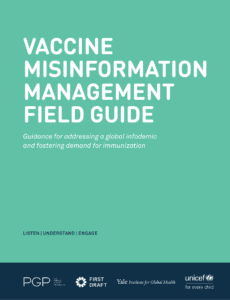Misinformation Alerts
Knowing what misinformation is being shared can help you generate effective messaging.
These insights are based on a combination of automated media monitoring and manual review by public health data analysts. Media data are publicly available data from many sources, such as social media, broadcast television, newspapers and magazines, news websites, online video, blogs, and more. Analysts from the Public Good Projects triangulate this data along with other data from fact checking organizations and investigative sources to provide an accurate, but not exhaustive, list of currently circulating misinformation.
Misinformation Alerts
Knowing what misinformation is being shared can help you generate effective messaging.
These insights are based on a combination of automated media monitoring and manual review by public health data analysts. Media data are publicly available data from many sources, such as social media, broadcast television, newspapers and magazines, news websites, online video, blogs, and more. Analysts from the Public Good Projects triangulate this data along with other data from fact checking organizations and investigative sources to provide an accurate, but not exhaustive, list of currently circulating misinformation.Alerts are categorized as high, medium, and low risk.
- High risk alerts: Narratives with widespread circulation across communities, high engagement, exponential velocity, and a high potential to impact health decisions. Are often more memorable than accurate information.
- Medium risk alerts: Narratives that are circulating in priority populations and pose some threat to health. Potential for further spread due to the tactics used or because of predicted velocity. Often highlights the questions and concerns of people.
- Low risk alerts: Narratives that are limited in reach, don’t impact your community, or lack the qualities necessary for future spread. May indicate information gaps, confusion, or concerns.
A widely circulating post on social media states that increases in Sudden Infant Death Syndrome (SIDS) began after vaccines became more widely available in the 1950s. The post uses a quote from a discredited physician who has published now-discredited vaccine research. Vaccines have not been shown to cause SIDS. Health researchers have previously documented that anti-vaccine organizations and advocates routinely reach out to mothers who have lost infants due to SIDS. Understandably intense feelings of grief and loss are capitalized upon to recruit women to the anti-vaccine movement, by claiming vaccines caused their child’s death rather than accidental or unknown causes. This tactic is expected to increase as more women receive COVID-19 vaccines.
Recommendation: Continuing to promote the safety and efficacy of vaccines, and the importance of public health measures, is in itself refuting this misinformation. Fact Checking Source(s): nbcnews.com, cdc.gov
A registered nurse practitioner has claimed in a video that mRNA technology, such as that found in COVID-19 vaccines, will teach the body to attack itself, leading to the development of autoimmune disease. The video has been seen hundreds of thousands of times on social media.
Recommendation: While addressing this misinformation could distract from priority talking points, updating FAQ’s and informational resources to explain the science and role of mRNA in vaccines is recommended. There continues to be substantial confusion among the public, and among health professionals, regarding mRNA. Fact Checking Source(s):apnews.com
A video was live-streamed on Facebook and has received tens of thousands of views, in which a woman records a screen share of data reported to the Vaccine Adverse Events Reporting System (VAERS). The woman incorrectly claims that COVID-19 vaccines cause adverse health reactions, including deaths. The VAERS is a passive surveillance system in which any individual can self-report any health problem following self-reported immunization. VAERS is the official US vaccine adverse event reporting system, maintained and monitored by the U.S. Department of Health and Human Services. However, reports to the VAERS do not determine if a vaccine caused a reaction or death; if a report is found to have merit, it begins the first of many subsequent steps taken by health officials to investigate adverse events.
Recommendation: VAERS and other sources of self-reported morbidity and mortality allegedly due to COVID-19 vaccines are increasingly of interest to anti-vaccine groups, conspiracy groups, and to individuals practicing armchair epidemiology. Interest is expected to continue, so public health talking points should continue to regularly promote vaccines and their safety and efficacy, and familiarity with the US’ vaccine adverse event reporting system is encouraged for public health communicators: https://vaers.hhs.gov/ Fact Checking Source(s): reuters.com
In a post that has been widely shared on social media, a former New York Times reporter is claiming that a person is 300 to 900 times more likely to die from a COVID-19 vaccine than the flu vaccine. This conclusion was made using data from the Vaccine Adverse Reporting System (VAERS). This post continues a trend of incorrectly using self-reported VAERS data to draw causal links between vaccines and adverse health events. The VAERS is a passive surveillance system in which any individual can self-report any health problem following self-reported immunization. VAERS is the official US vaccine adverse event reporting system, maintained and monitored by the U.S. Department of Health and Human Services. However, reports to the VAERS do not determine if a vaccine caused a reaction or death; if a report is found to have merit, it begins the first of many subsequent steps taken by health officials to investigate adverse events.
Recommendation: VAERS and other sources of self-reported morbidity and mortality allegedly due to COVID-19 vaccines are increasingly of interest to anti-vaccine groups, conspiracy groups, and to individuals practicing armchair epidemiology. Interest is expected to continue, so public health talking points should continue to regularly promote vaccines and their safety and efficacy, and familiarity with the US’ vaccine adverse event reporting system is encouraged for public health communicators: https://vaers.hhs.gov/ Fact Checking Source(s): healthfeedback.org, cdc.gov
Anti-vaccine groups are capitalizing on the death of a 58-year-old Virginia resident hours after receiving the first dose of the Pfizer/BioNTech COVID-19 vaccine. Reactions on social media claim that she was coerced into receiving the vaccine, that she is a "guinea pig" for pharmaceutical companies, and that the CDC has too many conflicts of interest to objectively investigate vaccine related adverse events. The death is under investigation, but to-date health officials have stated there appears to be no link between the vaccine and her death.
Recommendation: Addressing this misinformation could distract from priority talking points. Continuing to promote the safety and efficacy of COVID-19 vaccines, including the reporting and investigation of all adverse events following vaccination, is recommended. Fact Checking Source(s):nbc12.com, cdc.gov, vaers.hhs.gov, news.yahoo.com
Social media users are sharing a new website that compiles both anecdotal reports of adverse events following COVID-19 immunization and information reported to the Vaccine Adverse Event Reporting System (VAERS). VAERS is a passive surveillance system in which any individual can self-report any health problem following immunization, maintained and monitored by the U.S. Department of Health and Human Services. The new website is not affiliated with any health authority or research institution. The site directs its users to search for adverse events in its searchable database, and provides videos, some several hours long, taking viewers through individual self-reported events or exploring news stories on adverse events. Videos are hosted on sites where fact checking is left up to individual users. The site itself is linked to a network of sites known to promote conspiracy theories.
Recommendation: Self-reported morbidity and mortality allegedly due to COVID-19 vaccines has recently become a strategy by anti-vaccine and conspiracy organizations to undermine trust in government-backed reporting systems and investigations of adverse events. As this strategy is expected to continue, talking points should continue to regularly promote vaccines and their safety and efficacy, and familiarity with the US’ actual vaccine adverse event reporting system is encouraged for public health communicators: https://vaers.hhs.gov Fact Checking Source(s):cdc.gov, news.yahoo.com, vaers.hhs.gov
COVID-19 vaccines of indeterminate origin are appearing for sale online. Legitimate COVID-19 vaccines are not advertised or sold online.
Recommendation: While addressing this misinformation could distract from priority talking points, updating FAQ’s and informational resources to inform the public that legitimate COVID-19 vaccines will never be available for purchase online is recommended. Fact Checking Source(s): snopes.com 
A widely circulated article is claiming the CDC has inflated the number of COVID-19 deaths by 1600%, due to changing the way COVID-19 deaths are recorded. This claim had been fact-checked and found to be false previously, but has resurfaced due to routine guidance coming from the US National Center for Health Statistics on updating COVID-19 mortality data collection codes for a World Health Organization system (not the CDC). Death reporting has not changed significantly in the US during the pandemic, and health officials actually believe COVID-19 deaths are undercounted.
Recommendation: Addressing this misinformation could distract from priority talking points. Fact Checking Source(s):healthfeedback.org
A video is being shared in which an (unverified) Certified Nursing Assistant (CNA) claims that there were zero fatalities from COVID-19 in the nursing home he works in, until COVID-19 vaccinations began. Vaccine opponents on social media are hailing him as a hero and calling for more healthcare workers in nursing homes to come forward and act as "whistleblowers." Some social media users have stated that in remaining silent, healthcare workers are allowing their government to commit "geriatricide."
Recommendation: Addressing this misinformation could distract from priority talking points. Continuing to promote the safety and efficacy of COVID-19 vaccines, including the reporting and investigation of all adverse events following vaccination, is recommended. Fact Checking Source(s):cdc.gov, news.yahoo.com, vaers.hhs.gov
News is spreading that South Africa paused use of AstraZeneca-Oxford’s COVID-19 vaccine after a small-scale, unpublished study found it was less effective at preventing mild to moderate disease from the B1351 variant strain, dominant in South Africa. Misinformation is circulating that the vaccine is ineffective against all strains of the virus. Research studies are under way to confirm these preliminary findings, and to study the vaccine’s effectiveness in older adults, as some European countries the study’s earlier trials did not have sufficient data on this group. The World Health Organization has approved the AstraZeneca-Oxford vaccine for use in all adults, paving the way for its use in low- and middle-income countries.
Recommendation: While continuing to promote the safety and efficacy of COVID-19 vaccines should be prioritized, given the extraordinarily high public interest in COVID-19 vaccines updating any FAQ’s and informational resources that provide details on approved COVID-19 vaccines is recommended. Fact Checking Source(s):cidrap.umn.edu, theguardian.com, forbes.com
Alerts are categorized as high, medium, and low risk.
- High risk alerts: Narratives with widespread circulation across communities, high engagement, exponential velocity, and a high potential to impact health decisions. Are often more memorable than accurate information.
- Medium risk alerts: Narratives that are circulating in priority populations and pose some threat to health. Potential for further spread due to the tactics used or because of predicted velocity. Often highlights the questions and concerns of people.
- Low risk alerts: Narratives that are limited in reach, don’t impact your community, or lack the qualities necessary for future spread. May indicate information gaps, confusion, or concerns.
Vaccine Misinformation Guide
Get practical tips for addressing misinformation in this new guide. Click image to download, or see highlights.

